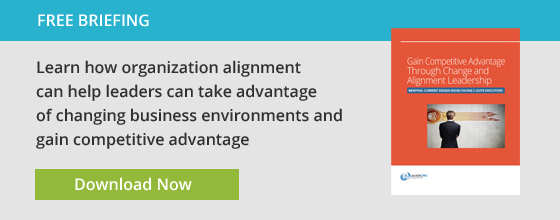In team sports, you hear the phrase, “You are only as good as your weakest player.” As it turns out, the same can often be said of organization design strategies. For a design to be truly successful, every employee within your organization must understand the strategic intent of the company and be willing to play their unique role in the organization. If someone doesn’t play their part, the brilliance, power, and differentiation of your strategy may be lost.
So, how do you help your employees—and especially those interfacing directly with customers—to understand and execute their roles in line with your organization’s strategy?
In a recent client engagement, we were asked to help redesign and deploy a new product development process that would deliver the strategic vision of the organization’s leaders. The leaders knew that to beat competitors they had to deliver consistent and timely new products to the market. Their product development process was highly matrixed and relied heavily on interdepartmental collaboration and coordination. Before the redesign, the complexities of the matrixed structure resulted in repeated product launch failures that proved costly to the organization’s reputation as well financial bottom line.
Part of this organization’s strategy was to design the work in a way that would increase speed to market and improve transparency in the product pipeline. Once designed, our role was to help the company and employees around the world align their actions to the new strategic design.
Among the many things that the company did to integrate the new strategic plan, three major elements stand out:
Understand the “Why.”
For employees to completely buy in to the vision and allow it to change the way they work, employees need to understand the rationale behind the change. In essence, understanding the rationale means they can answer: Why are we doing this? And why is this important?
For the company mentioned above, this meant providing employees time to absorb the change, regular and consistent information about the change, and regular opportunities to ask questions. This included informal sessions with managers, departmental huddles, and formalized huddles that were broadcast to employees. Significantly, all of these huddles and sessions were structured to be quick, precise, and allow for the majority of the time to answer questions from employees.
Although these meetings and huddles took time, they proved invaluable to the transformation work as employees had a chance to fully understand the changes and share feedback that shaped leaders’ decisions. Greater buy-in resulted as employees and stakeholders understood the “why” behind the new strategy and design.
Establish Guardrails.
One of the best ways to communicate strategic vision includes clarity of scope. What actions will be affected by the new strategic plan? How will the new vision interact with existing systems, policies, or processes? And, how broadly will the new strategy and design be implemented?
For the company we worked with, they determined early on what processes would be affected by the new strategic plan and those that would remain out of scope. For example, they had a prioritization and resourcing process that remained separate from the change occurring in the product development process. Although the two processes were very much related and had multiple touch points, the leadership team was clear that the prioritization and resourcing process was out of scope.
They also left the company management system virtually untouched. Instead, leaders clarified how the strategic change for the product development process aligned with, interacted with, and supported the company’s management system without making changes to it.
Provide Tools.
If we expect behavior change, we need to provide the resources necessary to sustain change. Without the right tools, it is too easy for employees to slip into their old processes even if they have bought in to the new system.
For the company cited above, the leadership team created accountability charts, process flows, and other descriptive documents (like standard operating procedures and training guides) to help employees know their roles and have the tools to answer questions and find out who they should be working with in the organizational matrix. Perhaps most importantly, employees received formal training on the new strategy, the new product development processes, their roles and responsibilities, and on how to conduct this work in context of the company’s management system. Combined, the tools and training led to one of the best roll-outs of a strategic plan we have seen.
The result of these three elements was an organization that understood the strategic intent of their product development process from top to bottom. Consequently, customer-facing employees conducted their work as if they were organization leaders themselves (they knew the strategic intent).
In the end, how do you help all employees understand and execute their job to the organization’s strategic plan? — you engage employees in the rationale for the change, you outline the guardrails so employees know what’s in play and what is out of play, and you provide the tools needed to help them succeed in their revised roles. Properly executed, these elements will help align employees to the strategic vision and deliver the desired, differentiated results to customers.






